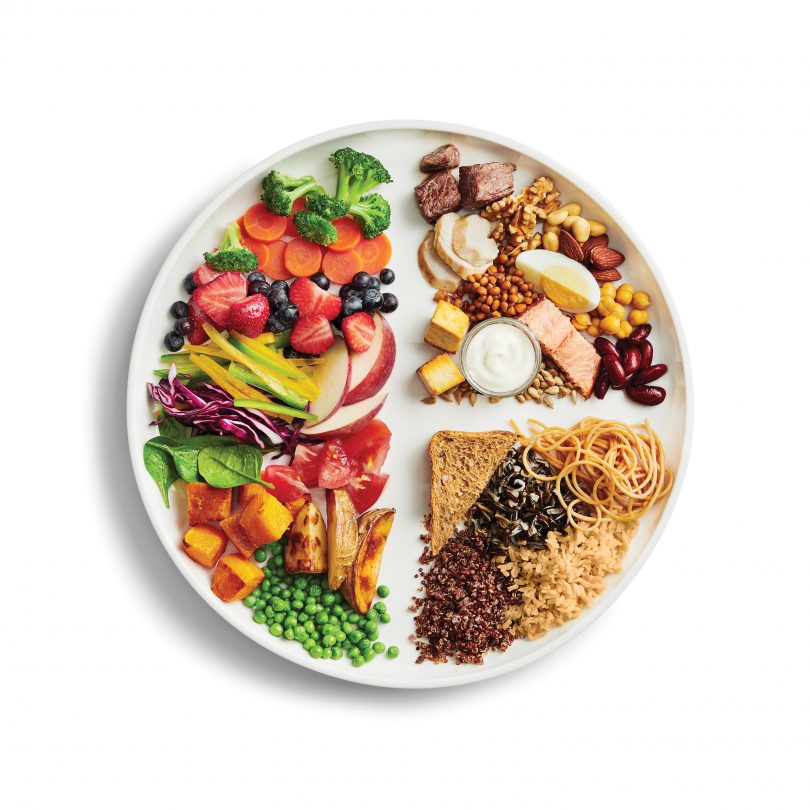By Tanya Choy and Emily Zamora
The new Canada’s Food Guide contains few surprises, thanks to the abundance of information shared by Health Canada during the revision and consultation process over the past three years, prior to its launch on January 22, 2019.
Now that it’s official, we can say we like the changes.
The document is a positive step towards a more whole-food and pattern-based approach to healthy eating.
The guide is simple, visual and flexible. It includes positive messages such as “Eat well. Live well. Eat a variety of healthy foods each day.” The Food Guide focuses not only on what Canadians should eat, but how they should eat to develop a positive relationship with food — important in a world where we are bombarded with the latest diets and food fads. It is encouraging to know that during the revision process Health Canada officials drafting the new Food Guide did not meet individually with representatives from the food and beverage industry, but instead, considered the results of two rounds of public consultations that were open to all Canadians.
Good-bye, four food groups. Hello three simpler groupings.
The biggest change is the replacement of the four distinct food groups with three simplified groupings:
Fruits and vegetables, protein foods (combines the previous “Meat and Alternatives” and “Milk and Alternatives” groups), and whole grain foods.
The new guide focuses on proportions instead of portions featuring a basic plate of real food (an appealing photo, not illustrations). The plate is not limited by portion size and number of daily servings.
Some have criticized the lack of specific guidance on portion size and daily servings, saying it’s difficult to determine how much to eat. But in reality, most people don’t measure their food, so in using the plate method, Canadians can more easily determine what healthy eating looks like. In addition, a balanced plate is more adaptable to different eating setting such as eating with others or at a restaurant. Canadians do need to be aware of “portion distortion” however, since plate sizes have increased in the past 20 years and may contribute to overeating.
What’s more, Canadians need to be aware of “portion distortion” since plate sizes have increased in the past 20 years and may contribute to overeating.
The plate method promotes a half plate of vegetables and fruit, a quarter plate of whole grain foods and a quarter plate of protein foods at every meal. The guide focuses on groupings that emphasize whole, unprocessed foods and mainly plant-based foods.
We like water as the beverage of choice
As for beverages, we’re pleased to see the main recommendation is water. The new guide no longer recommends fruit juice or sugar-sweetened milk products. We applaud this as an effort to limit the consumption of soda pop, juice and other sugar-sweetened beverages in hospitals, sports-centres and schools and, we hope, will support federal, provincial and municipal government’s efforts to decrease the marketing of less healthful food and beverage options to Canadians.
The most encouraging component of the new Canada’s Food Guide is its new emphasis on healthy eating behaviours, such as being mindful of your eating habits, cooking more often, eating with others, reading food labels, limiting foods high in sodium, sugars or saturated fat and being aware of food marketing.

Supporting documents released by Health Canada acknowledge that additional guidance may be needed for people living with certain health conditions or specific dietary requirements. For specific concerns or conditions, Canadians should contact a Registered Dietitian through their local health facility or our provincial contact centre, HealthLink BC.
Canada’s Dietary Guidelines for Health Professionals and Policy Makers document promotes and celebrates cultural diversity, and this updated version of Canada’s Food Guide, picturing whole foods of different origins, may be more adaptable to Canada’s diverse population.
When the hints of the new guide were being discussed in recent months there was heated debate around whether a food guide is even relevant. We believe it is.
It’s the basis of many school and institutional meal programs, public-health policy and nutrition-related funding. For example, programs such as Informed Dining BC, the BC School Fruit and Vegetable Nutritional Program and Food Skills for Families all help support BC residents’ nutritional wellbeing. With the help of supportive programming, Canada’s Food Guide helps inform a healthy eating pattern and shapes a basic standard for good nutrition in Canada. This is vital for Canadians as it provides a compass for nutrition in the midst of advertisements from the food industry, and the ongoing draw of fad diets.
Ultimately, healthy eating is more than food itself. It’s about lifestyle. And many Canadians’ eating lifestyles include unhealthy fast food, processed meals and takeout. Hopefully the new messages of this food guide will encourage Canadians to join together to eat well and live well.
Tanya Choy and Emily Zamora are registered dietitians at St. Paul’s Hospital in Vancouver





